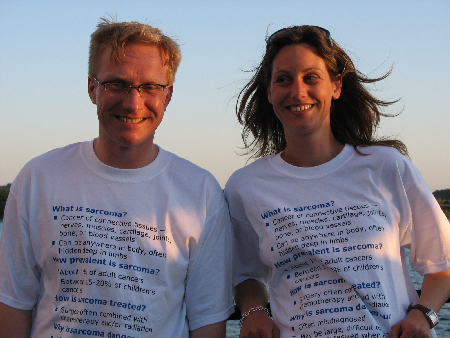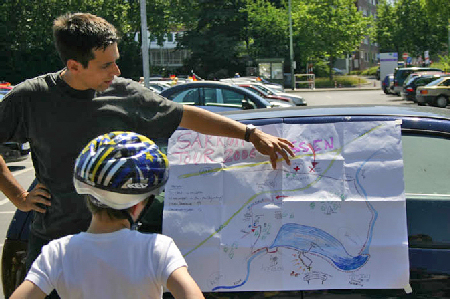Sarcoma Bike Tour Funds Awarded
In July 2006 , Team GIST Support participated in the Team Sarcoma Bike Tour organized by the Liddy Shriver Sarcoma Initiative. Team GIST Support, pictured below, included Megan Lamb, Rob Lamb, and Jonathan Craig.

The goal for Team GIST Support was to raise funds for two young researchers: Dr. Anette Duensing and Dr. Sebastian Bauer. On October 16 Bruce Shriver announced that Liddy Shriver Sarcoma Initiative is awarding $5000 each to our two recipients, with 85% raised by Team GIST Support. GIST Support International is proud to have partnered with Liddy Shriver Sarcoma Initiative in this global effort to increase awareness of sarcomas and monies available for sarcoma research.
For details about the riders’ experiences as they circled throughout the entire country of Denmark, check this related story with photos. Dr. Duensing and her husband, Dr. Stefan Duensing, were able to join the ride for one memorable day. Dr. Bauer organized a virtual ride in Essen, humorously described in his photo essay.
Dr. Duensing and Dr. Bauer are both working on innovative GIST research projects in their respective labs. Identifying new strategies to render GIST more susceptible to apoptosis (cell death) through molecularly targeted treatments is painstaking work, and we are grateful to these dedicated physicians for their efforts. Their photos are shown below with their comments about their curent GIST research efforts.
Dr. Duensing stated “I feel extremely honored to be recipient of a generous award from the Liddy Shriver Sarcoma Initiative, which was raised by “Team GIST Support a.k.a. Team GSI†during the Team Sarcoma 2006 bike tour in Denmark. These funds will be used to further elucidate of the precise mode of action of imatinib mesylate (Gleevec).

Imatinib is a potent small molecule kinase inhibitor that is very successful in the treatment of gastrointestinal stromal tumors (GIST). However, imatinib is not a cure, and unfortunately many patients acquire resistance to this drug over time. Identifying the exact mechanism of action of imatinib will be instrumental for the development of alternative treatment approaches for patients with primary or recurrent GISTs and novel strategies to circumvent imatinib resistance. We have shown that a molecule that is known to be involved in DNA double strand break repair is massively overexpressed in GIST cells after imatinib treatment. Further experiments revealed that the upregulation of this protein is critically involved in the induction of GIST cell death (apoptosis). We will expand these findings using various GIST cell line models as well as a GIST tissue microarray.”
Dr. Bauer commented: “Imatinib has greatly improved the treatment of patients with metastatic GIST. However, 20% of patients exhibit primary resistance and the majority of patients who respond to imatinib eventually progress. For these patients, alternative treatment strategies are urgently needed.

While the mechanisms of early or primary resistance to imatinib remain unclear, several mechanisms have been identified for patients with secondary resistance. Among those are additional mutations in the imatinib binding area, which reduce the ability of imatinib to bind and inhibit KIT. Therefore, current strategies focus on alternative KIT-Inhibitors or inhibitors of KIT-depending signaling intermediates. Our group focuses on the evaluation of potential therapeutically relevant inhibitors of KIT. Among those are direct and indirect KIT-inhibitors, which need to be extensively evaluated to enable the future use in patients. The contribution by GIST Support Internationl and the Liddy Shriver Sarcoma Foundation will help to co-finance Ph.D. student Thomas Mühlenberg, who currently evaluates an indirect approach to inhibit KIT. This approach may be helpful to overcome the problem of secondary mutations in imatinib-resistant GIST. In addition, funds will be used to partly defray costs for media for cell culture experiments as well as antibodies to test the molecular effects of the new treatments. We are most grateful for this contribution which is not only a financial help but also a tremendous motivation. We will do our best to fulfill the hope and expectations that are connected with this donation. Thank you.”

